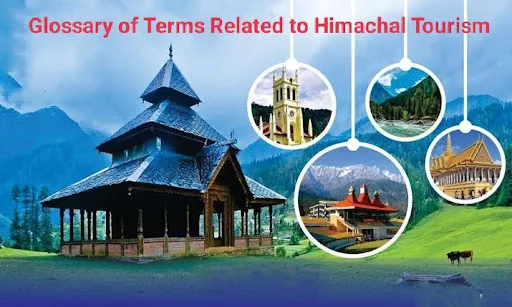Chapter 15: A Glossary of Terms Related to Himachal Pradesh Tourism
15.0 Introduction
This glossary provides clear definitions of key terms, local words, and phrases you’ll encounter when planning or enjoying a trip to Himachal Pradesh. Use it as a quick reference to deepen your understanding of regional culture, geography, activities, and logistical terms.
A
-
Abode Permit (Inner‑Line Permit)
A government‑issued permit required to enter protected border areas such as Spiti, Kinnaur, and Kaza. -
Abhyanga
In Ayurveda, a traditional oil massage using warm, herb‑infused oils for relaxation and detoxification. -
Altitude Sickness
A condition caused by rapid ascent to high elevations (above ~2,500 m), characterized by headaches, nausea, and fatigue.
B
-
Bhoj
A communal feast or banquet often organized during festivals, weddings, or as temple offerings. -
Botis
Hereditary chefs (Brahmins) who prepare the traditional Dham feast in Kullu, Mandi, and Kangra districts. -
Brahmatal Trek
A high‑altitude trek near Auli (Uttarakhand border) often accessed via the Dhauldhar foothills in Kangra.
C
-
Chadar Trek
A winter trek on the frozen Zanskar River in Ladakh; sometimes referred to by regional operators offering similar ice‑walk experiences in Himachal’s cold zones. -
Chha Gosht
A spicy mutton curry cooked in yogurt‐based gravy, originating from the Kangra Valley. -
Choula (Chola)
Traditional woolen coat worn by men in Kullu and Shimla, often paired with a Himachali cap.
D
-
Dhauldhar Range
A prominent sub‑range of the Himalayas near Dharamshala and Kangra, famed for trekking and the Triund ridge. -
Dham
A multi‑course ceremonial meal served on banana leaves during weddings and religious festivals in Kullu, Mandi, and Kangra. -
Dharamshala
A town in Kangra district, seat of the Tibetan government‑in‑exile and famous for its Buddhist monasteries.
G
-
Gaddi
A pastoral community native to the Kangra and Chamba regions, known for shepherding and distinctive woolen crafts. -
Gompa
A Tibetan Buddhist monastery found in Lahaul‑Spiti and Kinnaur, serving as centers for worship, learning, and art.
H
-
Hadimba Devi Temple
A 16th‑century wooden temple in Manali dedicated to Hidimbi, wife of Bhima from the Mahabharata. -
Homestay
Accommodation in a local family’s home, offering cultural immersion and home‑cooked meals at budget to mid‑range prices.
I
-
Inner‑Line Permit (ILP)
An official travel document required for Indian citizens to visit certain protected areas near international borders.
K
-
Kath‑Kuni Architecture
Traditional Himachali building technique using alternating layers of wood and stone for insulation and seismic resistance. -
Kinnaur Kailash
A sacred mountain peak in Kinnaur district, revered in Hindu mythology and a destination for pilgrimage and trekking. -
Kullu Dussehra
A week‑long festival in Kullu where deities from neighboring villages gather in colorful procession at Dhalpur Maidan.
L
-
Lahaul‑Spiti
A high‑altitude district in northeastern Himachal, characterized by cold desert landscapes and Tibetan Buddhist culture. -
Lavi Fair
A historic trade fair in Rampur Bushahr that traces its origins to Indo‑Tibetan barter exchanges.
M
-
Manimahesh Yatra
A pilgrimage trek to the sacred Manimahesh Lake at the foot of peak Kailash in Chamba district. -
Minjar Fair
A July–August festival in Chamba celebrating the maize harvest with processions, wrestling, and cultural performances. -
Monal
The Himalayan monal (Lophophorus impejanus), a brightly colored pheasant and state bird of Himachal Pradesh.
N
-
Nagaras (Nagara)
Large kettledrums used in temple music and during festivals to accompany processions and dances. -
Nati
A traditional folk dance of the Kullu, Shimla, and Sirmaur regions, performed in circles to rhythmic drumbeats.
P
-
Pahari
The collective term for the various dialects and cultural practices of the hill peoples of Himachal Pradesh. -
Paragliding
Adventure sport where participants glide from mountain ridges (e.g., Bir‑Billing) using a fabric wing and harness. -
Pattu
A handwoven woolen shawl or cloak, especially common among women in the Kinnaur and Kullu regions.
R
-
Rajma Chawal
Kidney beans cooked in spicy gravy, served with rice—a staple comfort food in Kangra and Chamba valleys. -
Rohtang Pass
A high mountain pass (3,978 m) near Manali, gateway to Lahaul‑Spiti and known for snow activities.
S
-
Shakti Peeth
Sacred shrines associated with the goddess Sati; Himachal hosts several, including Jwala Ji and Chintpurni. -
Shrikhand Mahadev
A pilgrimage trek to a Shivling‑shaped rock at 5,227 m in the Kullu region, symbolizing Lord Shiva’s devotion. -
Siddu
Steamed wheat or millet dough buns, often stuffed with poppy seeds, nuts, or jaggery.
T
-
Tabo Monastery
An 11th‑century Buddhist monastery in Spiti, famed for its ancient murals and manuscripts. -
Tirthan Valley
A scenic valley by the Tirthan River, gateway to the Great Himalayan National Park, known for trout fishing.
U
-
Unesco Heritage Toy Train
The Kalka–Shimla narrow‑gauge railway recognized for its scenic route, tunnels, and colonial‑era bridges.
V
-
Vashisht Hot Springs
Natural sulfurous hot springs near Manali believed to have therapeutic properties.
Z
-
Zanskar
A remote Himalayan sub‑region often accessed via Ladakh, but similar ice‐trek experiences are marketed in Himachal’s cold deserts.
How to Use This Glossary
-
Refer back when you encounter unfamiliar local words during travel planning or on the ground.
-
Combine terms—for example, “I need an Inner‑Line Permit for my Rohtang Pass trek” or “I’d love to stay in a homestay in Tirthan Valley.”
-
Keep a copy handy (print or digital) as your quick guide to Himachal’s rich tourism vocabulary.
Conclusion
With these terms demystified, you’re better equipped to navigate Himachal Pradesh’s landscapes, cultures, and experiences. May your journey through the hills be informed, immersive, and utterly unforgettable!

Comments
Post a Comment
"Thank you for seeking advice on your career journey! Our team is dedicated to providing personalized guidance on education and success. Please share your specific questions or concerns, and we'll assist you in navigating the path to a fulfilling and successful career."